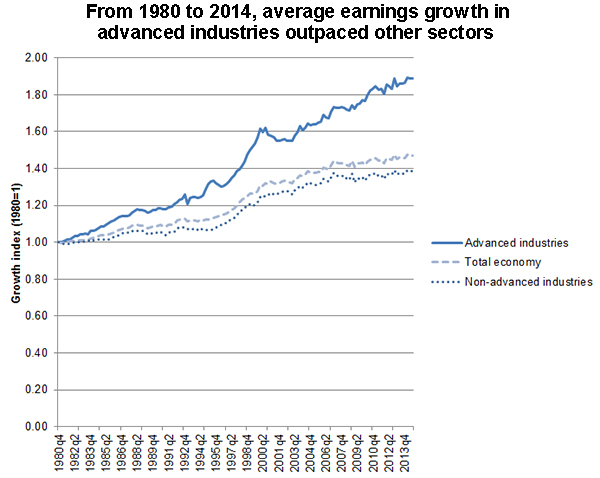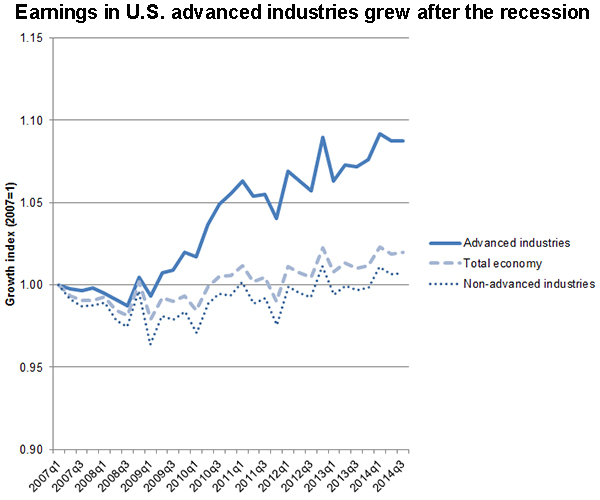Last week’s job report provided more evidence that the economy has recovered from the recession. GDP and employment have been growing nicely, and the unemployment rate has fallen to 5.5 percent from its high of 10 percent in 2009. But one huge problem dampens the celebration: wage stagnation. Adjusted for inflation, wages have only lately shown modest signs of ticking up, frustrating households and mystifying politicians, economists, and journalists.
Yet in one large and important sector of the economy—the amalgam of manufacturing, energy, and service businesses known as “advanced industries”—wages have grown strongly. We believe there is a lesson here.
As defined in our recent report, advanced industries are those that perform a high level of research and development per worker and employ a high percentage of workers in STEM (science, technology, engineering, and math) occupations. These industries provide the bulk of new inventions and products, while driving down consumer prices and spurring regional and national growth.
As our report showed, advanced industries are hiring and expanding job growth, and they are finding it relatively hard to fill vacancies.
As might be expected, wages are rising.
As of 2014, the average salary was $92,400 for advanced industry workers, compared to just $48,800 for workers outside advanced industries. Earnings growth has been impressive for several decades. While workers outside the advanced industries sector experienced only a 38 percent increase in salaries from 1980 to 2014, compensation in advanced industries rose 89 percent, adjusting for inflation (see Figure 1).

Source: Authors’ analysis of data from Moody’s Analytics, deflated by Bureau of Economic Analysis personal consumption expenditure price index.
Moreover, you don’t need a Ph.D. in physics to work in or earn a decent living at an advanced industry company: The salary premium is relatively high at all levels of education. For workers with less than a bachelor’s degree, earnings in advanced industries are between 50 percent and 70 percent higher than in other industries.
The source of these earnings data is Moody’s Analytics via the Bureau of Economic Analysis (BEA). The BEA offers the most comprehensive compensation information available, because the underlying source is administrative tax records, not small-sample surveys.

Source: Authors’ analysis of data from Moody’s Analytics, deflated by Bureau of Economic Analysis personal consumption expenditure price index
In the more immediate term, inflation-adjusted wages are up 9 percent across the advanced industries sector compared to before the recession (i.e., first quarter of 2007). Outside of it, wages are up just 1 percent (see Figure 2).
Why the difference? By definition, advanced industries are distinguished by their strong orientation to technology, innovation, and skilled workers to develop and scale up new products. By contrast, sectors like health care, education, and retail have neglected research and development and sought to employ, whenever possible, low-cost workers to deliver their products: Think health aides, billing claims processors, adjunct professors, and cashiers. The commitment to innovation typical of advanced industries positions them in high-value, high-margin global markets and leads them to hire and train skilled workers—at all levels of education—and pay them well.
Too many businesses have chosen the path that leads to stagnation. Solving America’s wage problems requires innovation, and the advanced industry sector shows how that can work.



Commentary
From advanced industries, a lesson about wages
March 10, 2015